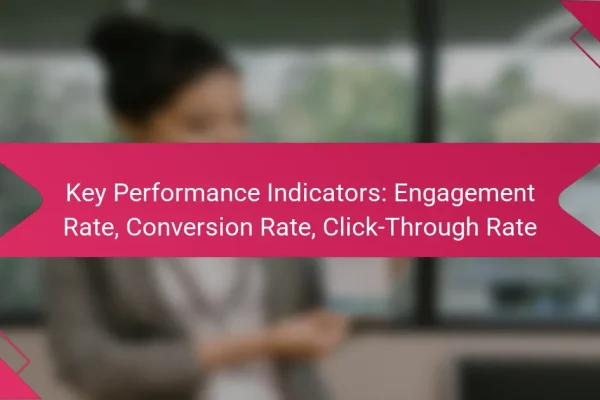How to track social media ad performance effectively?
To track social media ad performance effectively, utilize specialized tools and metrics that provide insights into engagement, reach, and conversion. This approach allows marketers to refine their strategies based on data-driven decisions.
Utilize Facebook Ads Manager
Facebook Ads Manager is a powerful tool for tracking the performance of your ads on the platform. It provides detailed metrics such as impressions, clicks, and conversions, allowing you to assess the effectiveness of your campaigns. Regularly reviewing these metrics helps you identify which ads are performing well and which need adjustments.
Make use of the breakdown feature to analyze performance by demographics, placement, and time. This granularity can reveal insights about your audience and help optimize future ads.
Leverage Google Analytics
Google Analytics can be integrated with your social media campaigns to provide a broader view of user behavior after they click on your ads. By setting up goals and tracking events, you can measure how social media traffic contributes to your overall website performance.
Focus on metrics like session duration, pages per session, and bounce rate to understand user engagement. This data can inform your ad targeting and content strategy.
Implement UTM parameters
UTM parameters are tags added to your URLs that allow you to track the performance of your campaigns in Google Analytics. By using UTM codes, you can identify which ads drive traffic and conversions, providing clarity on your ad spend effectiveness.
Ensure you create consistent and descriptive UTM parameters for each campaign. This practice will make it easier to analyze data and compare the performance of different ads or platforms.
Monitor engagement metrics
Engagement metrics such as likes, shares, comments, and click-through rates are crucial for assessing how well your ads resonate with your audience. High engagement often indicates that your content is relevant and appealing.
Set benchmarks for these metrics based on industry standards or past performance. Regularly monitoring these figures will help you adjust your content strategy to improve engagement over time.
Analyze conversion rates
Conversion rates measure the percentage of users who take a desired action after interacting with your ad, such as making a purchase or signing up for a newsletter. This metric is vital for understanding the return on investment (ROI) of your ad spend.
To improve conversion rates, consider A/B testing different ad creatives, calls to action, and landing pages. Analyzing these rates can help you pinpoint what drives conversions and optimize your campaigns accordingly.
What are the key performance indicators for social media ads?
The key performance indicators (KPIs) for social media ads are metrics that help assess the effectiveness of advertising campaigns. Understanding these KPIs allows marketers to optimize their strategies and improve return on investment.
Click-through rate (CTR)
Click-through rate (CTR) measures the percentage of users who click on an ad after seeing it. A higher CTR indicates that the ad is engaging and relevant to the audience. Typical CTRs for social media ads can range from 0.5% to 3%, depending on the platform and industry.
To improve CTR, focus on creating compelling ad copy and visually appealing images. A/B testing different headlines and calls to action can also help identify what resonates best with your audience.
Return on ad spend (ROAS)
Return on ad spend (ROAS) calculates the revenue generated for every dollar spent on advertising. A ROAS of 4:1 means that for every $1 spent, $4 in revenue is earned. Aiming for a ROAS of at least 3:1 is often considered a good benchmark.
To maximize ROAS, continually analyze which ads perform best and allocate more budget to those campaigns. Consider seasonal trends and adjust your ad spend accordingly to capitalize on peak buying times.
Cost per acquisition (CPA)
Cost per acquisition (CPA) measures the total cost of acquiring a customer through an ad campaign. This metric helps determine the efficiency of your advertising spend. A lower CPA indicates a more cost-effective campaign, with typical values varying widely by industry.
To reduce CPA, refine your target audience and optimize your ad placements. Utilizing retargeting strategies can also help convert users who have previously shown interest in your products or services.
Impressions and reach
Impressions refer to the total number of times an ad is displayed, while reach indicates the number of unique users who see the ad. Both metrics are essential for understanding the visibility of your campaigns. High impressions with low reach may suggest that the same users are seeing the ad multiple times.
To enhance impressions and reach, consider using a mix of organic and paid strategies. Engaging content that encourages sharing can also help increase organic reach, while targeted ads can expand your audience effectively.
How to optimize social media ad campaigns?
To optimize social media ad campaigns, focus on data-driven strategies that enhance performance and engagement. Key methods include A/B testing, adjusting targeting parameters, refining ad copy and visuals, and utilizing retargeting strategies.
A/B testing for creatives
A/B testing involves comparing two or more versions of an ad to determine which performs better. By changing one element at a time, such as images or headlines, you can identify what resonates most with your audience.
Run tests over a sufficient period to gather meaningful data, ideally a few days to a week, depending on your ad spend. Aim for a sample size that provides statistically significant results, generally in the low hundreds or more.
Adjust targeting parameters
Refining your targeting parameters is crucial for reaching the right audience. Use demographic data, interests, and behaviors to tailor your ads to specific segments, which can lead to higher engagement rates.
Consider testing different audience segments to find the most responsive groups. For example, targeting users based on their recent online behavior can yield better results than broad targeting.
Refine ad copy and visuals
Effective ad copy and visuals are essential for capturing attention. Ensure your messaging is clear, concise, and aligned with your brand voice. Use strong calls to action that encourage users to take the next step.
Visuals should be eye-catching and relevant to the content. Experiment with different styles and formats, such as videos or carousel ads, to see which garners the most interaction.
Utilize retargeting strategies
Retargeting allows you to reach users who have previously interacted with your brand but did not convert. By displaying ads to these users across various platforms, you can remind them of your offerings and encourage them to return.
Implement retargeting campaigns with tailored messages that address potential objections or highlight benefits. This strategy can significantly improve conversion rates, often by double digits, compared to standard campaigns.
What tools can enhance social media ad analytics?
Several tools can significantly improve social media ad analytics by providing insights into performance metrics, audience engagement, and campaign effectiveness. Utilizing these tools can help marketers make data-driven decisions to optimize their advertising strategies.
Hootsuite Analytics
Hootsuite Analytics offers a comprehensive dashboard that tracks key performance indicators (KPIs) across various social media platforms. Users can customize reports to focus on metrics like engagement rates, click-through rates, and conversions, making it easier to assess ad effectiveness.
One of its strengths is the ability to compare performance across different channels, allowing marketers to identify which platforms yield the best results. Hootsuite also integrates with other tools, enhancing its analytical capabilities.
Sprout Social
Sprout Social provides robust analytics that help users understand their audience and optimize ad campaigns. The platform features detailed reports on engagement, impressions, and audience demographics, which are crucial for tailoring ads to specific segments.
Additionally, Sprout Social’s social listening tools allow marketers to monitor brand mentions and sentiment, providing context to the raw data. This can inform future ad strategies and improve overall campaign performance.
AdEspresso
AdEspresso specializes in Facebook and Instagram ads, offering detailed analytics that break down ad performance by various factors such as audience targeting and ad placement. Users can easily track metrics like cost per click (CPC) and return on ad spend (ROAS).
The platform also allows for A/B testing, enabling marketers to experiment with different ad variations and measure their effectiveness. This iterative approach can lead to more efficient ad spending and better results over time.
HubSpot Marketing Hub
HubSpot Marketing Hub integrates social media analytics with broader marketing efforts, providing a holistic view of campaign performance. It tracks social media metrics alongside email and website analytics, allowing for a comprehensive understanding of customer journeys.
With HubSpot, users can create detailed reports that highlight the impact of social media ads on overall marketing goals. The tool’s automation features also help streamline reporting processes, saving time for marketers while ensuring they have access to valuable insights.
What are the challenges in social media ad tracking?
Social media ad tracking faces several challenges that can hinder accurate performance measurement. Key issues include data privacy regulations, the complexity of multi-channel attribution, and the evolving landscape of ad technologies.
Data privacy regulations
Data privacy regulations significantly impact social media ad tracking by restricting how user data can be collected and used. Laws such as the General Data Protection Regulation (GDPR) in Europe and the California Consumer Privacy Act (CCPA) in the United States impose strict guidelines on data handling, which can limit advertisers’ ability to track user behavior effectively.
Advertisers must navigate these regulations carefully to avoid hefty fines and ensure compliance. This often means implementing transparent data collection practices, obtaining user consent, and providing clear privacy policies. For example, using anonymized data can help mitigate privacy concerns while still allowing for some level of tracking.
To adapt to these regulations, businesses should regularly review their data collection methods and consider employing privacy-focused tracking solutions. Staying informed about changes in legislation is crucial to maintaining compliance and optimizing ad performance.











